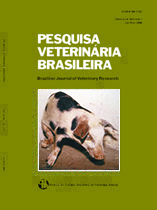 |
|
|
|
Year 2017 - Volume 37, Number 6
|

|
Minimally invasive ovariohysterectomy in Coatis (Nasua nasua), 37(6):627-629
|
ABSTRACT.- Minto B.W., Nagatsuyu C.E., Teixeira C.R., Zanuzzo F.S., Candido T.D., Diogo L.M.I. & Macedo A.S. 2017. Minimally invasive hysterectomy in Coatis (Nasua nasua). Pesquisa Veterinária Brasileira 37(6):627-629. Departamento de Clínica e Cirurgia Veterinária, Faculdade de Ciências Agrárias e Veterinárias, Universidade Estadual Paulista, Via de Acesso Prof. Paulo Donato Castellane s/n, Vila Nova Aparecida, Jaboticabal, SP 14884-900, Brazil. E-mail: brunobtu@yahoo.com.br
Some wildlife species, such as coatis, have a high degree of adaptability to adverse conditions, such as fragmented urban forests, increasingly common on the world stage. The increase in the number of these mesopredators causes drastic changes in the communities of smaller predators, interferes with reproductive success of trees, as well as becoming a form of exchange between domestic and wild areas, favoring the transmission of zoonosis and increasing the occurrence of attacks to animals or people. This report describes the use of minimally invasive hysterectomy in two individuals of the species Nasua nasua, which can be accomplished through the use of hook technique, commonly used to castrate dogs and cats. The small incision and healing speed of incised tissues are fundamental in wild life management since the postoperative care is limited by the behavior of these animals. This technique proved to be effective and can greatly reduce the morbidity of this procedure in coatis. |
| |
|
|
| |
|
 |